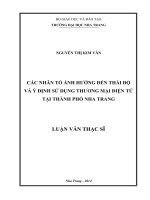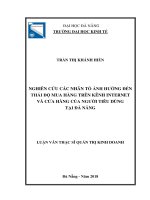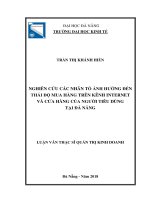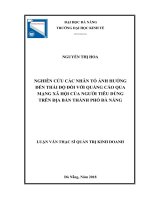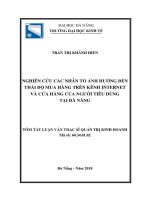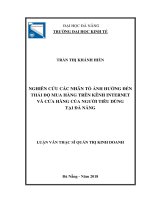Các nhân tố ảnh hưởng đến thái độ của giảng viên đối với vấn đề việc làm ở trường đại học sau tuổi nghỉ hưu
Bạn đang xem bản rút gọn của tài liệu. Xem và tải ngay bản đầy đủ của tài liệu tại đây (1.01 MB, 13 trang )
TẠP CHÍ KHOA HỌC
TRƯỜNG ĐẠI HỌC SƯ PHẠM TP HỒ CHÍ MINH
HO CHI MINH CITY UNIVERSITY OF EDUCATION
JOURNAL OF SCIENCE
Tập 18, Số 11 (2021): 1940-1952
ISSN:
2734-9918
Vol. 18, No. 11 (2021): 1940-1952
Website:
/>
Research Article*
FACTORS INFLUENCING LECTURERS’ ATTITUDE TOWARDS WORKING
AT UNIVERSITIES AFTER RETIREMENT AGE
Nguyen Tuan Kiet
Viet Nam National University Ho Chi Minh City, Vietnam
Corresponding author: Nguyen Tuan Kiet – Email:
Received: May 18, 2021; Revised: July 03, 2021; Accepted: August 20, 2021
ABSTRACT
Policies for retired employees have emerged as a hot issue for governmental bodies,
employers, and financial organizations. Retired lecturers at public university intend to move to
private ones to continue working. This research was conducted to identify psychosocial factors of
lecturers’ attitudes to working after the retirement age. To address this problem, this study surveyed
academic staff in Vietnamese universities followed by the statistical analysis of factors affecting
lecturers’ attitudes. The findings from the study showed that five out of six hypotheses were accepted.
The results can be used as a reference for university managers so that they could establish a
deliberate policy on the retirement issues. This study has contributed to the decision-making process
related to human resources management policies to improve the quality of education, promote a
healthy development and then achieve sustainable competitive advantages.
Keywords: factors; working attitudes; retirement age; lecturers; universities
1.
Introduction
At the present time in Vietnam, the number of old employees continuing working after
the regulated retirement age is noticeably increasing. Old workers’ attitudes to and
preferences for retirement vary widely across the spectrum of employment intentions.
Another important point is that recent demographic shifts have dramatically changed the
characteristics of retirement. Work and retirement have been traditionally regarded as
distinct states that reflect an automatic change in a life cycle from full-time employment to
non-work in a specific career. The changing mindset of retirement results in the demand for
interdisciplinary perspectives on later career. The “significance of the work-to-retirement
transition in the life course vary considerably between individuals” (Davies & Jenkins,
2013). Therefore, the issues around the labour force and retirement age are inextricably
referred to the country’s social insurance and pension system (Iams & Purcell, 2013). While
the United States abolished mandatory retirement policies with the final piece of legislation
Cite this article as: Nguyen Tuan Kiet (2021). Factors influencing lecturers’ attitude towards working at
universities after retirement age. Ho Chi Minh City University of Education Journal of Science, 18(11),
1940-1952.
1940
HCMUE Journal of Science
Nguyen Tuan Kiet
in 1986 (Warren & Kelloway, 2010) and while in the UK mandatory retirement ages were
largely lifted in 2011 (Davies & Cartwright, 2010), Vietnam has only begun disputes over
changes in the nature and age of retirement. Next, the old employees’ feelings about and
attitudes to retirement appear to be varied. In line with this, Shultz and Henkens (2010) have
affirmed that “retirement is connected to not only the availability of financial resources and
health, but also to the work content and environments, and the psychological processes that
precede late career employment and retirement decisions.” These determinants differ in
magnitude across professional fields and between personality and demographic realities
(Turner, 2005). Therefore, an insight into these determinants can help understand these
people’s multifaceted attitudes towards the retirement transition. Also, a better
understanding of a mutual match between the expectations of older employees and their
relevant organizations also helps to build retirement programs that can facilitate prior
planning by both the older employee and the organization (Shen, 2009).
This study focuses on identifying their attitudes towards working after the regulated
retirement age in Vietnam, and hence seeks to answer the following research questions:
Research question 1: What are the determinants of retired lecturers’ attitudes
to working?
Research question 2: How do these factors influence the overall results?
2.
Literature review and Methodology
2.1. Literature review
2.1.1. Some basic concepts
Retirement theories have naturally evolved through the industrial and technological
advancements over the past two centuries. It would be more appropriate to state that
“retirement is plural” (Beehr & Adams, 2003). It is hardly ever defined who is retired and
who is not because the notion of retirement itself is hard to identify. An individual’s
retirement may be defined in the aspects of full retirement and part-time retirement.
- Self-reported retirement (Anderson & Burkhauser, 1985)
- Receiving pension income (Boaz, 1987)
- Decrease in income (Gustman & Steinmeiner, 1986).
Another theory often discussed by researchers in the area of retirement is the theory of
planned behaviour (Beehr, 2003). The theory of planned behavior, developed by Ajzen
(1991), indicates that "intentions to perform behaviors of different kinds can be predicted
with high accuracy from attitudes toward the behavior, subjective norms, and perceived
behavioral control; and these intentions, together with perceptions of behavioral norms, and
perceived behavioral control, account for considerable variance in the actual behavior"
(p.179).
In addition, retirement is a complicated and crucial transitional process for Vietnamese
academic employees. In higher education, the definition of retirement is no longer perceived
1941
HCMUE Journal of Science
Vol. 18, No. 11 (2021): 1940-1952
as a straightforward process. In other words, retirement is not “a point in time” or “cliff
edge” (Davies & Cartwright, 2011), rather than a “boundaryless” flow of work life (Harley
et al., 2004). Thus, like other countries, retirement in Vietnam itself must be understood in
the way that individual lecturers go between work and non-work at an organization.
2.1.2. Related studies
Previous research has identified factors determining retirement decisions. They consist
of passion for work and commitment to work. Typical research of this kind was conducted
by Barnes at al. (2003), Hair et al. (2004), and Patrickson and Ranzijn (2004). Some other
factors such as social interests, quality of social relationships, and leisure activities have
positive impacts on the decisions to retire (Phillipson & Smith, 2005). Still some other
research considered the factors such as status, gender, age, income, health and family
responsibilities to determine their magnitude of influence on the retirement decision-making
process (Smeaton & McKay, 2003). However, most of these studies have focused only on
examining factors related to decisions to retire early or to retire at the legal pre-defined age
as of Zappalà et al. (2008), but not on the intention to continue working past the retirement
age. Common findings and initial discussions are often on the extremes of the work-nonwork
continuum, seldom saying at what point along the continuum the retirement attitudes become
a taxonomic hierarchy. Therefore, there is a clear need for an interdisciplinary emphasis on
retirement transition. This focus will help to adequately understand how retirement is linked
to not only the demographic factors, but also to the social attachment at work and at home,
and the psychological and psychosocial factors that predict retirement attitudes and work
plan after the retirement age.
Shacklock and Brunetto (2011) have followed and extended parts of the Meaning of
Working (MOW) theoretical model (MOW International Research Team, 1987; Westwood
and Lock, 2003). The research implemented a cross-sectional, survey-based, self-reported
strategy to collect data on 1,000 older employees’ retirement attitudes. The authors then
developed a clear picture about the impact of work-related variables on the meanings of
working to older employees. Shacklock et al. (2011) also included the factors related to
financial circumstances in their study because this factor has a decisive impact upon
retirement attitudes (to reduce or stop working, or retiring). The research found that not only
previously tested (health and financial) but also of four work-related variables such as the
importance of working, the environment of work, and the flexibility of working
arrangements, and interests outside of work have much influence on older employees’
attitudes to continue paid working.
2.2. Research methodology
This research was conducted in universities in Ho Chi Minh City. The survey
investigated the psychological and psychosocial factors affecting the the retirement
transition of Vietnamese lecturers. The criterion to select participants in this study was that
1942
HCMUE Journal of Science
Nguyen Tuan Kiet
they are academic staff “eligible to retire”. The potential respondents were from several
universities and institutes in Ho Chi Minh City.
In addition, six prominent lecturers including three female and three male academics
staff were invited and joined the study. Through relationship, the researcher knows four
lecturers. The other two were invited using a snowballing technique. These lecturers were
teaching, or they were working as a lecturer and a researcher or manager. They were different
in age, gender, financial health, academic rank, and managerial status. They had been told
about the research and the objectives of study before interviews were conducted face to face.
Each interview lasted on average 45 minutes.
In-depth interviews were conducted to explore the contexts of lecturers’ attitudes to
working after the regulated retirement age and to identify what factors affecting their
attitudes to continue working. A survey was then used. Glesne and Peshkin (1992) affirmed
that this approach used numbers, statistical methods, and numerical measurements to seek a
general description or analyses that were easily replicable for other researchers. The
questionnaire was piloted with 30 lecturers. Some scales were modified after this pilot.
In this research, all valid survey responses from respondents were used. After
identifying unidimensionality, reliability, and validity for the scale, all items were confirmed
applying a common factor analysis.
A total of 424 responses (with a response rate of over 90.4 percent) were used for
further analysis. With 35 items for factor analysis, and a sample of 424 responses, the ratio
between cases to variable is 12.11: 1, satisfying the requirement specified by Hair et al.
(1995), Tabachnick and Fidell (2007), and Naunnally (1978). The 35-item questionnaire was
administered to 424 lecturers at universities in Ho Chi Minh City. Of these items, five items
were then used as dependent variables in the analysis. Respondents answered each question
with a five-point Likert scale. The questionnaire also included questions related to the
background characteristics of the respondents.
3.
Results and discussion
3.1. An overview of socio-demographic characteristics of the respondents
As previously noted, convenience sampling was implemented. The responses were
gathered within a day or a week later. A total of 452 responses were collected and collated
among 500 questionnaires sent out. After screening and a validity check, 28 responses were
removed from further analysis. The response rate is 90.4%.
Categories
ACADEMIC BACKGROUND
Demographics
Natural sciences
Social sciences and
Humanities
Technology
Information technology
Business – Management
1943
Frequency
76
Percent
17.9
87
20.5
58
66
98
13.7
15.6
23.1
HCMUE Journal of Science
Vol. 18, No. 11 (2021): 1940-1952
Health care
Others
< 5 years
5 - 10 years
11 - 15 years
16 - 20 years
> 20 years
< 5 years
5 - 10 years
11 - 15 years
16 - 20 years
> 20 years
Female
Male
36 - 45 years old
46 - 50 years old
51 - 55 years old
56 - 60 years old
Over 60 years old
Single
Married with children
Married with no children
< 9 million
9 - < 15 million
15 - < 20 million
20 - < 25 million
> 25 million
Bachelor degree
Master degree
PhD degree
Post doctorate Degree
Others
Lecturer
Senior lecturers
Associate professor
Professor
Others
Teaching
Researching
Managing
Teaching and
researching
Teaching and managing
TIMEWORK
SENIORITY
GENDER
AGE
MARITAL STATUS
INCOME
DEGREE
ACARANK
TASK
Total
1944
35
4
48
83
80
119
94
21
20
28
86
269
189
235
56
48
160
154
6
35
378
11
40
210
144
29
1
13
228
164
16
3
129
187
86
20
2
209
4
22
8.3
0.9
11.3
19.6
18.9
28.1
22.2
5.0
4.7
6.6
20.3
63.4
44.6
55.4
13.2
11.3
37.7
36.3
1.4
8.3
89.2
2.6
9.4
49.5
34.0
6.8
0.2
3.1
53.8
38.7
3.8
0.7
30.4
44.1
20.3
4.7
0.5
49.3
0.9
5.2
107
25.2
82
424
19.3
100.0
HCMUE Journal of Science
Nguyen Tuan Kiet
Table 1 shows that that the majority of the responding lecturers were from 51 to 60
years old which meets the initial requirements. However, the percentage of lecturers under
and equal 50 years old is 24.5 percent, 51-55 years old is 37.7 percent, and over 55 years old
is 37.7 percent. The reason why the 36-45 age group was included in the data since the study
concentrated on the determinants affecting the lecturers when they were expected to be at
the age of retirement. This matches the initial purpose of the investigation. Regarding their
career age and the amount of time they have been working for their current university, 373
lecturers (84.36 percent) of total 424 have spent more than 10 years teaching. Besides, 293
of total 424 lecturers (69.2 percent) have committed to their current university for over ten
years. Their age and amount of time at the current university can help confirm a correlation
between their organizational commitment and their older age.
As regards their tasks at the universities, 209 lecturers (49.3 percent) worked as a fulltime lecturers (only teaching), while 107 lecturers (25.2 percent) did both teaching and
researching. Eighty-two lecturers were academic staff and manager (program coordinator,
deans, or center head). The number of lecturers working as a manager only is 22. Four
lecturers identified themselves as researchers.
3.2. The distribution of factors toward the attitudes of the respondents
3.2.1. Regression analysis to the attitudes of retirement
Multiple regression analysis was done with the dependent variables, namely attitudes to
working after normal retirement age and two types of the independent variables: positive
relationship (Organizational commitment, Retirement anxiety, Intrinsic motivation, Social
interaction), and inverse relationship (Financial comfort, Leisure orientation). The results of
regression analysis were presented in Table 1.
Table 1. Summary of regression testing
Model
R
Model Summaryb
R Square Adjusted R Square Std. Error of the Estimate Durbin-Watson
1 .646a
.418
.409
.68681
a. Predictors: (Constant), SOCINT, LEIORI, FICOMF, RETANX, INTMOT, ORGCOM
b. Dependent Variable: CONWOR
1.450
Table 2. Analysis of standard deviation
Model
ANOVAa
Sum of Squares
df
Mean Square
F
Sig.
Regression
141.069
6
23.511
49.844
.000b
1
Residual
196.700
417
.472
Total
337.769
423
a. Dependent Variable: CONWOR
b. Predictors: (Constant), SOCINT, LEIORI, FICOMF, RETANX, INTMOT, ORGCOM
1945
HCMUE Journal of Science
Vol. 18, No. 11 (2021): 1940-1952
Table 3. Regression Analysis
Model
(Constant)
Coefficientsa
Unstandardized
Standardized
Coefficients
Coefficients
B
Std. Error
Beta
-4.049E-017
ORGCOM
.104
LEIORI
-.103
1 RETANX
.175
FICOMF
-.062
INTMOT
.286
SOCINT
.357
a. Dependent Variable: CONWOR
.033
.042
.045
.039
.037
.044
.045
.110
-.108
.187
-.066
.293
.335
t
Collinearity
Statistics
Sig.
Tolerance VIF
.000
1.000
2.442
-2.305
4.510
-1.671
6.509
7.974
.015
.022
.000
.096
.000
.000
.684
.633
.811
.899
.688
.790
1.462
1.579
1.233
1.112
1.453
1.265
Adjusted R Square (R2) of the research model is 40.9%. This means 40.9% revealed
that the percentage of variation explained by only the independent variables influencing the
attitudes to working. Besides, F-test showed Sig = .000, so the proposed research model was
confirmed with the data set.
The regression result was presented in Table 3. For the hypothesis 1: Intrinsic
motivation has a positive relationship with attitudes to working after normal retirement age.
The independent predictor in Hypothesis 1 contributed significantly to the variation in the
dependent variable, meaning that intrinsic motivation predicted older lecturers’ attitudes to
working after normal retirement age with p<.05 (sig=.000) and =.293. For the Hypothesis
2, organizational commitment has a positive relationship with attitudes to working after
normal retirement age. The independent predictor in Hypothesis 2 contributed significantly
to the variation in the dependent variable, meaning that organizational commitment
predicted older lecturers’ attitudes to working after normal retirement age with p<.05
(sig=.015) and =.110. For the Hypothesis 3, retirement anxiety has a positive relationship
with attitudes to working after normal retirement age. The independent predictor in
Hypothesis 3 contributed significantly to the variation in the dependent variable, meaning
that retirement anxiety predicted older lecturers’ attitudes to working after normal retirement
age with p<.05 (sig=.000) and =.187. For the Hypothesis 4, social interaction has a positive
relationship with intentions to continue working past normal retirement age. The
independent predictor in Hypothesis 4 contributed significantly to the variation in the
dependent variable, meaning that social interaction predicted older lecturers’ attitudes with
p<.05 (sig=.000) and =.335. For the Hypothesis 5, leisure orientation has a negative
relationship with the attitudes to working. The independent predictor in Hypothesis 5
contributed to the variation in the dependent variable, meaning that leisure orientation
predicted older lecturers’ attitudes with p<.05 (sig=.022) and = -.108.
1946
HCMUE Journal of Science
Nguyen Tuan Kiet
3.2.2. Psychosocial and psychological factors to the overall attitudes
For the psychosocial factors, after EFA, the variables that establish the psychosocial
predictor of attitudes to working after normal retirement age are intrinsic motivation and
organizational commitment. The former influences the attitudes to working more strongly
than the latter. Regarding intrinsic motivation, the most predictive role of intrinsic
motivation found in this research is in line with the findings by Shacklock (2008). This is
also in accordance with Ekert and DeViney (1993)’s study which showed the attachment to
work and love of job have been influential. The core nature of intrinsic motivation focuses
on the meaning of passion for work, as in the item My work (as a lecturer) is more than a
job to me; it is a passion. Intrinsic and passion are defined in the Merriam-Webster dictionary
as an essential nature of and a strong feeling of enthusiasm or excitement about doing a job.
Some previous studies have revealed that young employees and older employees are
different in the way they perceive the importance of work. Older employees have been
described to be more intrinsically attached to the work for which they are passionate
(Rhodes, 1983, Riodan et al., 2003). In academia in Vietnam, despite a career of low pay,
the number of lecturers backing at the teaching career has not been as many as that of other
industries, (“Teaching career draws new crowds” in Vietnam News, 2013). A possible
explanation involves in lecturers’ love for teaching (Tuoitre, 2013). For the organizational
commitment, like previous research in the literature, organizational commitment has been
found to have a positive correlation with intentions to work beyond normal retirement age
(Chen et al.; Mowday et al.; 1982). Organizational commitment is closely related to
Ashforth’s (2001) role theory, which describes that work role is vital to employees. It is both
a self-concept and a personal identity. Where there is a passion for work , there is a sense of
identity and self-concept, and therefore, there is an organizational commitment. The contral
aspect of work lies on these characteristics. These are supported in other research such as
the study by Schmidt and Lee (2008). Taylor and MacFarlane Shore (1995) also pointed out
that the more attached employees were to an organization, the more likely they are to stay
longer in their career. Teaching is no exception. It is the work of heart.
For the psychological factors, three psychological factors of attitudes are social
interaction, retirement anxiety, and leisure orientation. For the social interaction, this factor
was also well-explained in Shacklock’s (2006) research with =.264, p<.001. One of the
most attractive activities to older lecturers was interacting with others while at work.
Moreover, interpersonal relationships at work and social relationships they built at work
proved to be a crucial factor in the working life, especially more crucial later life (Smeaton
& McKay, 2003; Choo, 1999). Contiuing to work after retirement age is value for older
lecturers. They can work with younger lecturer generations, share knowledge and
experience, and even avoid being left behind the new. Teaching is characterised as an
intensively human job. Lecturers always meet and work with a large number of students. A
1947
HCMUE Journal of Science
Vol. 18, No. 11 (2021): 1940-1952
sudden exit from teaching at the retirement age is somehow frustrating. For leisure, it has a
negative relationship with attitudes to continue working. For many employees, retirement is
a “new beginning” or “beginning of an end” (Horstern & Warpner, 1985). They will
prioritize leisure activities. However, this finding suggests that lecturers are not leisure oriented activity.
4.
Conclusion
4.1. Some major points
The identified predictors of attitudes to working after normal retirement age
contributed greatly to university leaders’ decisions on human resources policies such as on
retention of experienced and qualified older lecturers. Through effective actions, the quality
of teaching and training can be improved and accordingly helps universities promote a
healthy development and then achieve sustainable competitive advantages.
The result of regression analysis indicated the significant differences between male
lecturers and female lecturers. As of the female group, there were four factors such as
organizational commitment, leisure interaction, intrinsic motivation, and social interaction
that influence their attitudes to working after normal retirement age. As of the male group,
there were three factors including retirement anxiety, intrinsic motivation, and social
interaction that impact their attitudes to working after normal retirement age. On the one
hand, it can be interpreted that female lecturer will continue working beyond normal
retirement age if they feel attached to their university and if the organizational environment
and management are encouraging. On the other hand, when female lecturers wish to have
more spare time after retirement for their favorite activities or family caring, they tend to
retire early. For male lecturers, two factors including organizational commitment and leisure
interaction did not impact their attitudes to working after normal retirement age, whereas
retirement anxiety did. This can be explained that male lecturers traditionally are “breadwinner” or the people that are supposed to support their family. Therefore, they are worried
about retirement and find it difficult to adjust to a new non-work pattern. Also, they are
afraid of becoming a burden in the family. Overall, despite differences in attitudes to
retirement intentions between male lecturers and female lecturers, both groups shared two
factors: social interaction and intrinsic motivation.
4.2. Managerial implications
In the current situation at universities located in Ho Chi Minh City, the severe shortage
of qualified and experienced lecturers is facing the university management board. More and
more qualified lecturers have been invited by different universities. In the field of higher
education, lecturers are regarded as the back bone of a university. Of the valuable assets such
as modern facilities and equipment, the teaching staff is always the most valuable. Brain
drain at a university means it is in obvious danger in terms of loss of reputation and decrease
in teaching and training quality. Possible solutions to this challenging problem can be based
1948
HCMUE Journal of Science
Nguyen Tuan Kiet
the findings of this research. It is necessary for universities to frame a policy on older
lecturers. Keeping experienced and qualified lecturers who also share the culture of the
university is much more profitable than merely nourishing young lectures. The fact that older
lecturers work and share knowledge with young lecturers is the best way of investing in the
next generation. This unique characteristic only exists in higher education. To be successful
in retaining and encouraging older lecturers to stay longer with their university, the following
factors must be taken into consideration.
Enhancing the interaction between older lecturers and young lecturers. The first factor
is older lecturers’ needs for social interaction. As discussed, social interaction strongly
influences older lecturers’ attitudes to working after normal retirement age. Activities such
as training session, seminars, and projects for older lecturers to share would be one of the
ways of pulling them back to the organization. The result showed their commitment to the
university. This is a supportive factor that needs taking into account.
The second factor is older lecturers’ intrinsic motivation. As a saying, “love always
keep you back,” intrinsic motivation means “my work is more than just a job to me. It is a
passion. This factor is like a sufficient condition for their attitudes to working after normal
retirement age. Teaching is the work of the heart. Any genuine lecturer has a deep love for
teaching.
Strengthening the affective commitment and reducing the working time for woman
lecturers. The regression analysis results for gender differences with the attitudes indicated
that interrelationship with colleagues (social interaction) and love for teaching career
(intrinsic motivation) determine both man lecturers’ and woman lecturers’ attitudes. On the
other hand, woman lecturers tend to work after retirement age because they are attached to
their university. They are willing to work after retirement age when they still have time for
leisure activities.
Landing a psychological contract with men lecturers. For man lecturers, they work
after retirement age because they are worried about retiring. A psychological contract will
make them feel being cordially invited to make longer contribution to the university. When
they find it safe and respectful to remain in the university, they will work after retirement
age in the same university that they have been part of it for a long time.
Establishing a retirement planning program for older lecturers. Regarding career
seniority, both groups of lecturers indicated that they loved their career, tended to socialize,
and are worried about retirement (or do not feel happy with retirement). However, with those
lecturers whose career seniority is more than 20 years are emotionally attached to their
university and want to work less. They want to spend time for their leisure activities. This
group of 20-year seniority is highly representative of lecturers in general. What they prefer
in retirement is a gradual retirement transition. This is similar to what was discussed in the
literature: retirement is a long and sophisticated process. Therefore, a wide-ranging
1949
HCMUE Journal of Science
Vol. 18, No. 11 (2021): 1940-1952
recommendation as well as an optimal managerial solution is establishing a retirement
planning program in the university. Only with this program will lecturers who are close to
retirement age be able feel in control with retirement. Also, retirement will not be as heavy.
The identified predictors of attitudes to working after normal retirement age
contributed greatly to university leaders’ decisions on human resources policies such as on
retention of experienced and qualified older lecturers. Through effective actions, the quality
of teaching and training can be improved and accordingly helps universities promote a
healthy development and then achieve sustainable competitive advantage.
4.3. Limitations of the research
Parallel with key findings, this research has its own shortcomings.
First and foremost, the main limitation of this research is that this research was
conducted with convenience sampling. The sample were taken from 26 universities located
only in Ho Chi Minh City, so the sample is not representative to generalize to a wider
population. Besides, later research could focus on those who are blue-collar, because whitecollar people like lecturers could differ the blue-collar people in attitudes to working beyond
normal retirement age.
Secondly, this research used multiple regression analysis to explore the correlation
between the variables which are believed as independent variables and the dependent
variables. Therefore, this approach did not reveal the correlation between the independent
variables of the research model.
Conflict of Interest: Author have no conflict of interest to declare.
REFERENCES
Anderson. K., & Burkhauser, R. (1985). The retirement health nexus. The Journal of Human
Resources, 20(3), 315-330.
Adams, G. A., & Beehr, T. A. (Eds). (2003). Retirement: Reasons, Processes and Results. New York,
NY: Springer Publishing, 59-87.
Barnes. A. (2003). Paths to Retirement: What light the Workforce Circumstances and Retirement
Attitudes of Older Australian Survey sheds on this issue. Seniors and Means Test Branch,
Department of Families and Community Services.
Boaz. R. (1987). Work as a response to low and decreasing real income during retirement. Research
on ageing, 9(4), 428-440
Davies, E., & Cartwright, S. (2011). Psychological and psychosocial predictors of attitudes to
working past normal retirement age. Employee Relations, 33(3), 249-268.
Davies, E., & Jenkins, A. (2013). Work-to-retirement transition of academic staff: attitudes and
experiencess. Employee Relations, 35(3), 322-338
1950
HCMUE Journal of Science
Nguyen Tuan Kiet
Gustman. A., & Steinmeiner. T. (1986). A disaggregated, structural analysis of retirement by race,
difficulty of work and health. The Review of Economics and Statistics, U.S.A.
Hair J. F., Black W. C., Babin B. J., Anderson R. E., & Tatham R. L. (2006). Multivariate data
analysis 6th Edition. New Jersey: Pearson Prentice Hall.
Harley, S., Muller-Camen, M., & Collin, A. (2004). From academic communities to managed
organisations: the implications for academic careers in UK and German universities. Journal
of Vocational Behavior, 64(2), 329-345.
Iams, H. M., & Purcell, P. J. (2013) . The Impact of Retirement Account Distributions on Measures
of
Family
Income.
Social
Security
Bulletin,
73(2).
Retrieved
from
/>Patrickson, M., & Ranzijn, R. (2004). Bounded choices in work and retirement in Australia.
Employee Relations, 26(4), 422-432.
Phillipson, C., & Smith, A. (2005). Extending Working Life: A Review of the Research Literature,
299. Norwich: Department for Work and Pensions.
Shacklock, K., & Brunetto, Y. (2011). A model of older workers' intentions to continue working.
Personnel Review, 40(2), 252-274.
Shacklock, K. (2006). Extended working lives? The meaning of working to older university workers
in Australia”. Journal of Human Resources Development and Management, 6(2-4), 161-73.
Shacklock, K. H. (2008). Shall I stay? The Meaning of Working to Older Workers. VDM Verlag Dr
Muller, Saarbrucken.
Shen, J. (2009). University academics' psychological contracts and their fulfillment. Journal of
Management Development, 20(6), 575-591.
Shultz, K. S., & Henkens, K. (2010). The changing nature of retirement. International Journal of
Manpower, 31(3), 265-270
Smeaton, D., & McKay, S. (2003). Working after State Pension Age: Quantitative Analysis.
Department of Work and Pensions, London.
Turner, J. (2005). Social Security Pensionable Age in OECD Countries: 1949-2035. AARP Public
Policy Institute. Retrieved from />Warren, A. M., & Kelloway, E. K. (2010). Retirement decisions in the context of the abolishment of
mandatory retirement. International Journal of Manpower, 31(3), 286-305.
Westwood, R., & Lok, P. (2003). The meaning of work in Chinese contexts: a comparative study.
International Journal of Cross Cultural Management, 3(2), 139-65.
Zappalà, S., Depolo, M., Fraccaroli, F., Guglielmi, D., & Sarchielli, G. (2008). Postponing job
retirement? Psychosocial influences on the preference for early or late retirement.
Development International, 13(2), 150-167.
1951
HCMUE Journal of Science
Vol. 18, No. 11 (2021): 1940-1952
CÁC NHÂN TỐ ẢNH HƯỞNG ĐẾN THÁI ĐỘ CỦA GIẢNG VIÊN
ĐỐI VỚI VẤN ĐỀ VIỆC LÀM Ở TRƯỜNG ĐẠI HỌC SAU TUỔI NGHỈ HƯU
Nguyễn Tuấn Kiệt
Đại học Quốc gia Thành phố Hồ Chí Minh, Việt Nam
Tác giả liên hệ: Nguyễn Tuấn Kiệt – Email:
Ngày nhận bài: 18-5-2021; ngày nhận bài sửa: 03-7-2021; ngày duyệt đăng: 20-8-2021
TĨM TẮT
Chính sách dành cho người nghỉ hưu đang là vấn đề được các cơ quan thuộc Chính phủ, người
sử dụng lao động, các tổ chức tài chính và người lao động quan tâm. Các giảng viên về hưu thuộc
các trường đại học cơng lập có xu hướng chuyển sang công tác tại các trường tư thục để được tiếp
tục làm việc. Bài viết này nghiên cứu các yếu tố tâm lí và xã hội về thái độ làm việc của giảng viên
lớn tuổi sau khi nghỉ hưu. Để giải quyết vấn đề này, bài viết xem xét đội ngũ giảng viên trong các
trường đại học Việt Nam bằng cách phân tích sự khác biệt mang tính thống kê của các nhóm ảnh
hưởng đến thái độ của giảng viên lớn tuổi. Kết quả nghiên cứu định lượng đã chỉ ra 5 trong số 6 giả
thuyết của mơ hình nghiên cứu được hỗ trợ, đóng vai trị là tài liệu tham khảo cho các nhà quản lí
trường đại học để có thể thiết lập một chính sách cân nhắc về vấn đề nghỉ hưu. Kết quả này có thể
góp phần giúp lãnh đạo trường đại học trong việc đưa ra những quyết định hợp lí về chính sách
quản lí nguồn nhân lực nhằm nâng cao chất lượng giảng dạy và đào tạo; từ đó, thúc đẩy sự phát
triển lành mạnh, đạt được những lợi thế cạnh tranh bền vững ở các trường đại học.
Từ khóa: nhân tố ảnh hưởng; thái độ làm việc; tuổi nghỉ hưu; giảng viên; trường đại học
1952
